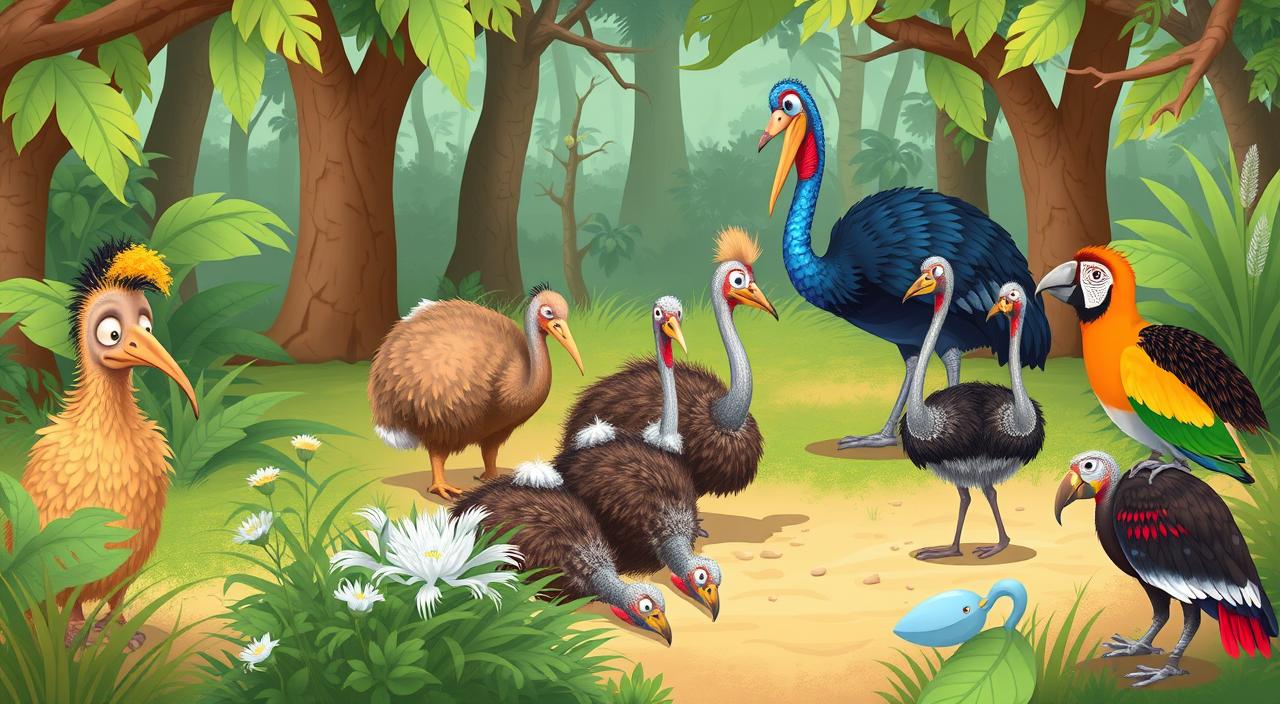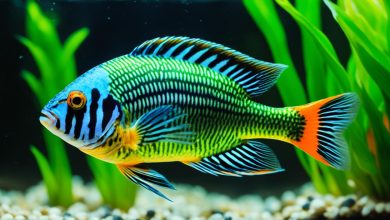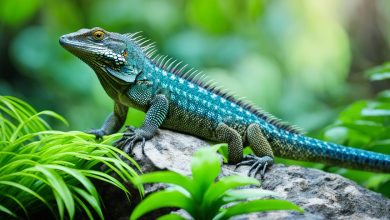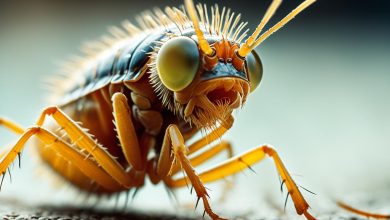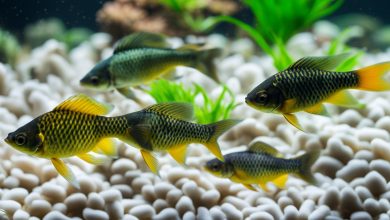Bird intelligence fascinates many. Some birds show remarkable problem-solving skills, while others seem less mentally gifted. This exploration uncovers surprising findings about avian cognition.
The intelligence spectrum of birds is vast. We often hear about smart crows and parrots. However, some birds, like emus and lilac-breasted rollers, have a reputation for being less clever.
What defines a bird’s intelligence? Is it behavior, brain size, or other factors? Let’s challenge our perceptions and explore avian cognition.
We’ll take a fun look at the 10 least intelligent birds. From clumsy kakapos to window-crashing cardinals, these birds have unique charms. They may not win brain contests, but they play important roles in nature.
Understanding Avian Intelligence: How We Measure Bird Smarts
Scientists are captivated by the cognitive abilities of feathered problem-solvers. Crows and parrots keep amazing us with their intellect. Let’s dive into how researchers measure the smarts of these clever creatures.
Cognitive tests for birds
Researchers use various tests to gauge avian intelligence. The Krushinsky problem assesses reasoning skills, with crows excelling while pigeons struggle.
The String Test evaluates problem-solving abilities. Even pigeons have shown success on touchscreens.
The Box Test reveals how environmental factors influence cognition. High-altitude chickadees outperform their lowland counterparts in this test.
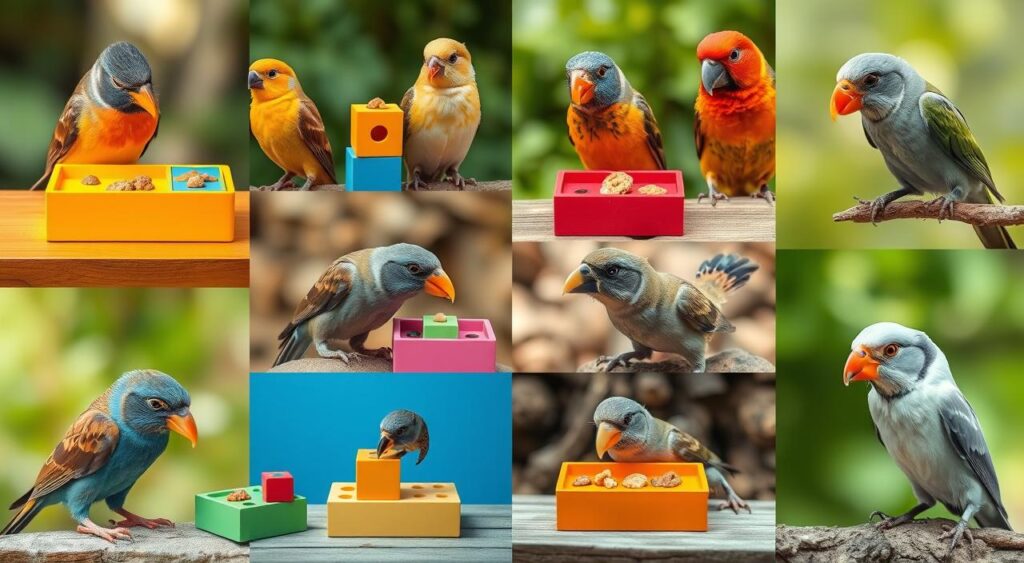
The role of brain size in bird intelligence
Brain size plays a crucial role in avian smarts. Crows and parrots have larger brains relative to their body size.
These brainy birds can count up to seven. They also understand complex concepts like “same” and “different.”
Some clever birds, like Alex the African Grey Parrot, have learned over 100 labels. They’ve also developed basic communication skills.
Environmental factors influencing avian cognition
The environment shapes bird intelligence. Social structures impact cognitive development, as seen in Siberian jays’ Family Ties Test.
Habitat complexity also plays a role. Challenging conditions may boost problem-solving skills in birds.
Long-term studies on parrots have revealed surprising results. These feathered problem-solvers can rival great apes and dolphins in cognitive abilities.
| Bird Species | Cognitive Ability | Test Performance |
|---|---|---|
| Crows | Problem-solving | Excelled in Aesop’s Fable Test |
| Scrub Jays | Time perception | Understood food perishability |
| Cockatoos | Rhythm sensitivity | Danced to music like 4-year-old humans |
The Kakapo: New Zealand’s Flightless Parrot with a Small Brain
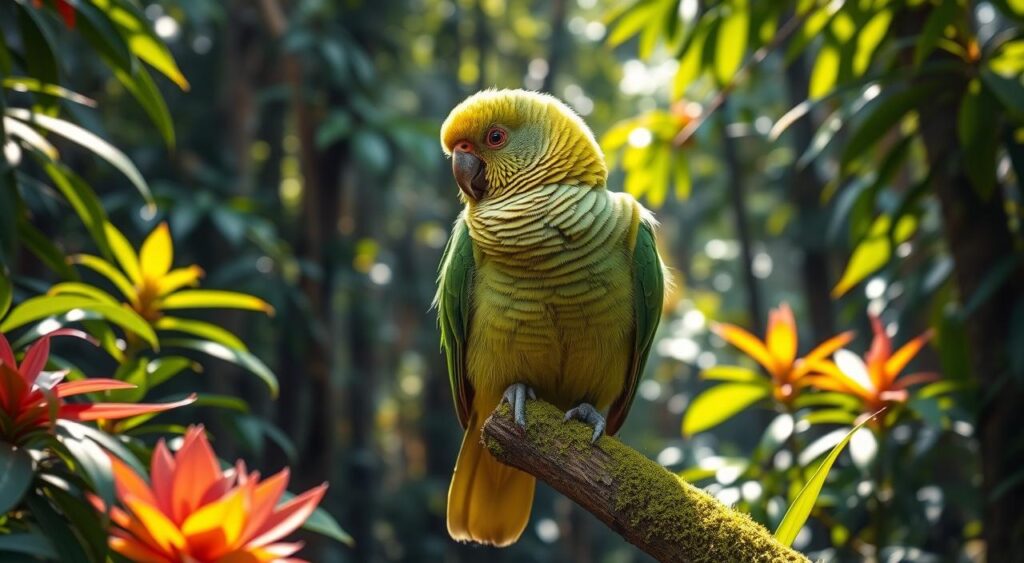
The kakapo is a unique parrot native to New Zealand. It’s the world’s only flightless parrot, challenging our understanding of smart birds. Adult males weigh 1.5-3 kilograms, while females weigh 0.95-1.6 kilograms, making them the heaviest parrots.
Kakapos lack the smarts often seen in clever birds. Their small brain leads to poor survival skills. When in danger, these night birds freeze, climb trees, or try to jump.
The Kakapo Recovery Programme started in 1995 to save these rare birds. From just 51 birds in 1995, their numbers grew to 247 by 2023. This slow growth shows how hard it is for kakapos to survive.
- Kakapos can live over 90 years, making them one of the longest-lived birds
- Males start breeding at 4 years old, females at 6 years old
- During breeding season, males walk up to 4 miles to reach special arenas
Kakapos fascinate scientists with their odd traits. They evolved in a place without predators. This shaped their current vulnerable status. Their story reminds us how delicate nature’s balance can be.
Emus: Australia’s Large but Less Brainy Birds
Emus are Australia’s native birds and the world’s second-largest. Despite their size, these flightless birds lack smarts. Researcher Lefebvre’s avian IQ index labeled emus the “world’s most stupid bird,” sparking debate in Australia.
Physical characteristics of emus
Emus have powerful legs for sprinting up to 30 miles per hour. They can jump 7 feet high. Their size and strength made them tough opponents in the 1932 Great Emu War.
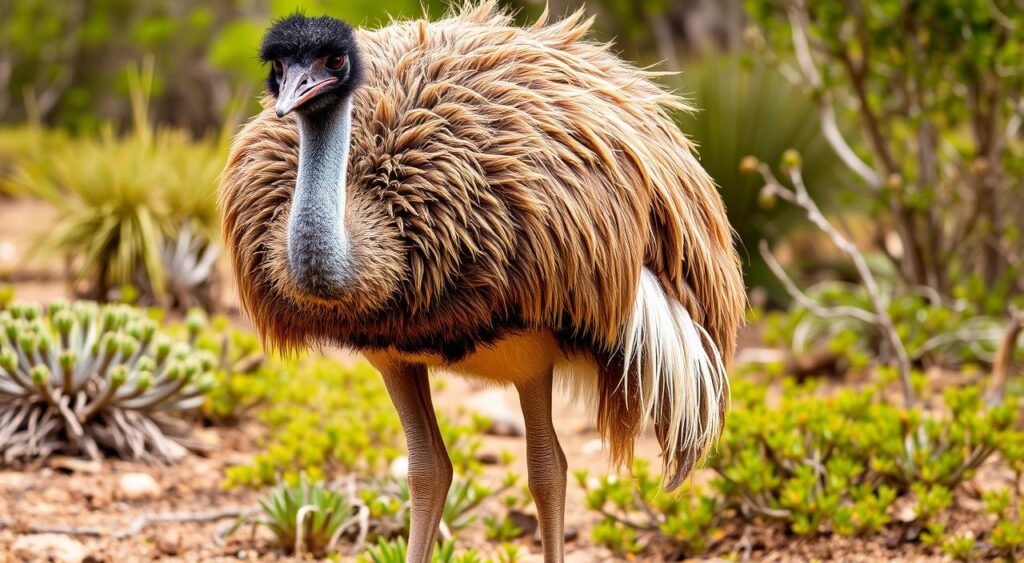
Behavioral traits indicating low intelligence
Emus show poor problem-solving skills despite their physical abilities. In 1932, 20,000 emus wreaked havoc on Western Australian farms. This event showed their poor adaptability to new environments.
The military’s campaign against these birds failed. This further highlighted the emus’ unique behavior and resilience.
Comparison to other ratites
Emus and ostriches show similar low cognitive function. This may stem from their evolution and environmental adaptations. In contrast, crows, ravens, and parrots rank among the smartest birds.
These intelligent birds showcase innovative behaviors. They also have larger brain sizes relative to their bodies.
| Bird Species | Intelligence Ranking | Notable Traits |
|---|---|---|
| Corvids (Crows, Ravens) | High | Innovative behaviors, problem-solving skills |
| Parrots | High | Complex vocal abilities, tool use |
| Emus | Low | Limited adaptability, poor problem-solving |
| Ostriches | Low | Similar cognitive limitations to emus |
Ostriches: Big Bodies, Small Brains, and Misconceptions
Ostriches are fascinating creatures with impressive physical attributes. These flightless birds stand out in the avian world. They may not be known for their intelligence, but they have other remarkable qualities.
Ostriches are the fastest running birds on Earth. They can sprint at speeds up to 43 mph. Adult ostriches weigh between 250 and 300 pounds and can reach heights of 9 feet.
Ostriches don’t bury their heads in sand when threatened. Instead, they lower their heads to blend with their surroundings. This survival tactic is often misunderstood as a sign of low intelligence.
| Characteristic | Measurement |
|---|---|
| Maximum Height | 2.7 meters |
| Weight | Over 150 kg |
| Top Speed | 70 km/h |
| Lifespan in Wild | 30-40 years |
| Body Length | 2.1-2.7 meters |
Ostriches lay enormous eggs, weighing about 3 pounds each. A single nest can contain up to 30-40 eggs. Their diet mainly consists of plants, but they sometimes eat small animals and insects.
The Lilac-Breasted Roller: Beauty Over Brains
The Lilac-Breasted Roller is a stunning bird with 23 colors on its body. It’s a true marvel in the animal world. However, this bird isn’t known for its smarts.

Colorful Appearance and Habitat
This vibrant bird is the national symbol of Kenya and Botswana. It’s about the size of a Robin and does acrobatic flights during mating season. You can find these birds in open woodlands and savannas across eastern and southern Africa.
Poor Nesting Choices and Vulnerability to Predators
Lilac-Breasted Rollers make risky choices that hurt their survival. They often perch in exposed areas, making them easy prey. Their nesting habits are also questionable.
Unlike smarter birds, they build nests in very high places. This puts their young at greater risk of harm.
Questionable Dust Bathing Behavior
These birds take dust baths, which seems unwise for their safety. While it helps control parasites, it clouds their vision temporarily. This leaves them open to attacks from predators.
These behaviors show a lack of smarts. That’s why they’re seen as one of the less intelligent bird species.
| Characteristic | Description |
|---|---|
| Colors | 23 |
| Size | Similar to Robin |
| Mating Behavior | Tumbling flights |
| National Bird of | Kenya and Botswana |
| Intelligence Ranking | Low among birds |
Northern Fulmars: Seabirds with Questionable Parenting Skills
Northern Fulmars inhabit the North Atlantic and North Pacific subarctic regions. These seabirds make parenting choices that puzzle bird enthusiasts and researchers. Their avian cognition isn’t their strong suit.
Female fulmars have an unusual nesting habit. They return to land once to lay an egg on rocky ledges. This risky behavior endangers their offspring, contradicting expectations of intelligent birds.
| Behavior | Northern Fulmar | Great Blue Heron |
|---|---|---|
| Egg-laying frequency | Once per season | Multiple times |
| Nesting location | Precarious rocky ledges | Safer tree-top nests |
| Hatching success rate | Low due to risky nesting | 5 out of 5 eggs hatched |
| Fledging success | Limited due to poor parental care | All 5 nestlings fledged |
Northern Fulmars show limited parental care compared to other seabirds. Their poor nesting choices and offspring neglect contribute to their reputation. These traits make them seem less intelligent than their feathered peers.
Despite their flaws, Northern Fulmars play a vital role in ecosystems. Studies show these coastal surface-feeders thrive in surveyed habitats. Their adaptability shines despite their lack of parental skills.
Turkeys: Confused Birds or Misunderstood Geniuses?
Turkeys aren’t as dim-witted as we once thought. These feathered problem-solvers might be smarter than we give them credit for. Let’s explore the true nature of turkey intelligence.
Debunking Turkey Myths
Turkeys don’t drown by staring at the sky during rainstorms. This myth comes from a genetic condition called tetanic torticollar spasms. Turkeys have monocular vision, allowing them to focus on two things at once.
However, this unique vision may make it harder for them to spot predators.
The Impact of Domestication on Turkey Intelligence
Domestication has likely changed turkeys’ cognitive abilities. Wild turkeys show more complex behaviors and problem-solving skills than their domesticated relatives. In Massachusetts, wild turkey numbers grew from 37 in the 1970s to over 25,000 today.
Social Behavior and Cognition in Wild Turkeys
Scientists now think turkeys may be smarter than we realized. Wild turkeys have complex social structures and communication methods. Their ability to thrive in forests and suburbs shows their cognitive flexibility.
| Trait | Wild Turkeys | Domesticated Turkeys |
|---|---|---|
| Problem-solving skills | High | Moderate |
| Social complexity | Complex hierarchies | Simplified social structure |
| Adaptability | Highly adaptable | Less adaptable |
Turkeys deserve a second look when it comes to bird intelligence. Their successful comeback in many areas shows they’re far from confused. These birds might just be the misunderstood geniuses of the avian world.
Cardinals: The Window-Crashers of the Bird World
Cardinals, those bright red birds, have a peculiar habit. They keep crashing into windows! This behavior is causing quite a stir in the bird world.
Male cardinals are the main offenders. During mating season, they become very territorial. They mistake their reflection for a rival and attack the glass repeatedly.
This isn’t a one-time event. Some cardinals have been seen hitting the same window for years. These birds seem less clever when it comes to mirrors.
Dr. Dan Baldassarre, a cardinal behavior expert, studied this odd habit. He found that cardinals do this all year, not just during mating season. The window’s condition doesn’t matter; they keep crashing.
People have tried many ways to stop this behavior. They’ve used hawk cutouts, blue tape, and window netting. But these birds often ignore these tricks and continue fighting their reflections.
This window-crashing habit is a serious issue. About 1 billion birds die from window strikes yearly in the U.S. Some cities have started “Lights Out” programs to reduce bird collisions at night.
So, when you see a cardinal tapping your window, remember this. It’s not trying to get your attention. It’s just having a confusing fight with itself!
Killdeer: Masters of Misdirection or Just Plain Dumb?
Killdeers aren’t known for their smarts. These large plovers live in North and South America. Their behavior often raises questions about their intelligence.
Unlike smarter birds, Killdeers make risky choices. They don’t show the problem-solving skills of crows or parrots.
The broken-wing display: clever tactic or risky behavior?
Killdeers perform a broken-wing display when predators approach. They pretend to be injured to lure threats away. This tactic is risky and could backfire.
Nesting habits and vulnerability
Killdeers often lay eggs in exposed areas. This makes their offspring easy targets for predators. Smart birds like ravens choose safer nesting spots.
Killdeer’s place in the plover family
Killdeers lack the tool-using skills of green herons. They don’t have complex social behaviors like Harris’s hawks. Their survival tactics are risky but effective.
We shouldn’t dismiss Killdeers as unintelligent. They may not be the smartest, but they’ve found ways to survive.
FAQ
Q: How is avian intelligence measured?
A: Avian intelligence is measured through cognitive tests for birds. These tests assess problem-solving skills, memory, and adaptive behaviors. They’re designed to evaluate various aspects of bird intelligence.
Q: What role does brain size play in bird intelligence?
A: Brain size is crucial for bird intelligence. Some species have large brains compared to their body size. This affects their cognitive abilities significantly.
Q: What environmental factors influence cognitive development in birds?
A: Habitat complexity and social structures greatly impact birds’ cognitive growth. These environmental factors shape how birds think and learn. They play a key role in avian intelligence.
Q: Why is the Kakapo considered one of the least intelligent birds?
A: The Kakapo, from New Zealand, is seen as less intelligent. It evolved without predators, leading to poor defense mechanisms. Its small brain relative to body size also contributes to this perception.
Q: How do emus compare to other ratites in terms of intelligence?
A: Emus show similar low cognitive function as other ratites like ostriches. Their evolutionary history and environment may explain this. These factors have shaped their mental capabilities over time.
Q: What misconceptions exist about ostrich intelligence?
A: People often think ostriches bury their heads in sand when scared. Actually, they lie flat on the ground. Their light-colored heads and necks help them blend in with surroundings.
Q: Why is the Lilac-Breasted Roller considered one of the least intelligent birds?
A: The Lilac-Breasted Roller has poor survival strategies. It perches in exposed areas and builds high nests. Taking dust baths that impair vision also shows lack of intelligence.
Q: What makes Northern Fulmars’ parenting decisions questionable?
A: Northern Fulmars make poor parenting choices. They build nests on dangerous rocky ledges above the ocean. This puts their eggs at high risk, showing little concern for offspring safety.
Q: Are turkeys really as unintelligent as commonly believed?
A: New studies suggest turkeys might be smarter than we thought. More research on avian cognition is needed. Genetic conditions and domestication have affected their mental abilities.
Q: Why are cardinals considered less intelligent birds?
A: Male cardinals often fly into glass windows repeatedly. They seem unable to learn from these encounters. This behavior contributes to their reputation as less intelligent birds.
Q: What behavior of Killdeers is often seen as a sign of low intelligence?
A: Killdeers perform a broken-wing display to lure predators from nests. This risky behavior endangers the adult bird. They also nest in exposed areas, leaving eggs and chicks vulnerable.
